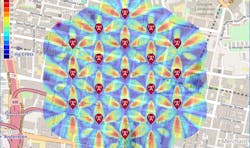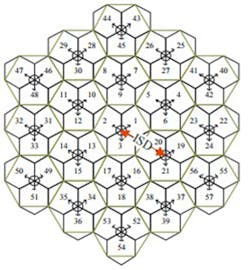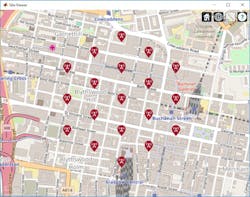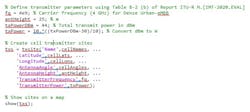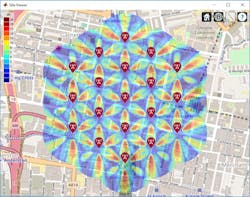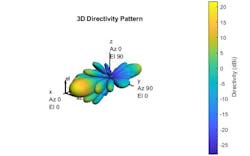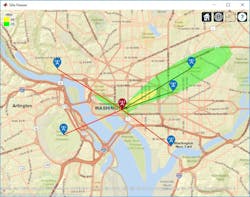Algorithms to Antenna: Visualize Antenna-Array and SINR Patterns on a Map
I have covered many aspects of modeling antenna elements and antenna arrays in “Algorithms to Antenna: Achieve System Performance Goals with Less Hardware” and “Algorithms to Antenna: Designing an Antenna Array.” The focus to date has been on evaluating an antenna-array design based on the beam pattern of the array. For some projects, it’s also helpful to visualize the antenna pattern on a map. I would like to introduce you to a few examples that show how these patterns can be displayed on a map in MATLAB.
Since my previous examples focused on 5G antenna arrays, I start this example by constructing a 5G urban macro-cell test environment. For this use case, you can visualize the signal-to-interference-plus-noise ratio (SINR) within the network on a map. The test environment is based on guidelines defined in Report ITU-R M.[IMT-2020.EVAL] for evaluating 5G radio technologies.
From this reference, an urban environment with high user density and traffic loads (Dense Urban-eMBB) is used. The test environment consists of a hexagonal cell network, which is also based on the network layout for 4G technologies defined in Section 8.3 of Report ITU-R M.2135-1.
1. Sites are placed in a hexagonal pattern in this test network layout.
Figure 1 shows a layout in which 19 sites are placed in a hexagonal configuration. Each site consists of three cells. The distance between adjacent sites, shown as ISD in Fig. 1, is 200 m.
In this example, we use the MathWorks office in Glasgow, Scotland, as the center location. Once you define the names, latitudes, longitudes, and antenna angles of each cell transmitter, you can create transmitter sites with your own parameters, as well as configuration parameters defined for Dense Urban-eMBB.
2. Transmitter sites for a 5G urban macro-cell test environment are revealed.
The plot in Figure 2 uses the "OpenStreet-Map" basemap in the Site Viewer in Antenna Toolbox. The MATLAB code to display the transmitter sites is as follows:
Section 8.5 of ITU-R report defines antenna characteristics for base-station antennas. The antenna is modeled as having one or more antenna panels, where each panel has one or more antenna elements. This type of system can be modeled directly using the techniques I described in the blog posts mentioned in the first paragraph.
3. A microstrip patch element is used for SINR visualization of a 5G urban macro-cell test environment.
We’re able to visualize the SINR for the test scenario using a specific antenna element and propagation model. The specific antenna element and array can be modified to match your design. Figure 3 shows the results with a microstrip patch similar to one I discussed in “Algorithms to Antenna: Designing an Antenna Array.” The code to display the visualization is as follows:
You can also substitute different antenna-array designs and propagation models to conduct what-if scenarios. The tools easily allow you to visualize the impact of missing cells or alternate network configurations.
Antenna Beam-Pattern Scanning on a Map
The second example I want to discuss shows how to visualize a changing coverage map of an antenna array as it scans a sweep of angles. Similar to the transmitter sites shown above, receiver sites can also be created and shown on a map. A coverage map can be displayed while steering the antenna array.
Figure 4 shows a pattern generated from a 7-×-7 uniform rectangular array (URA). Your own array design and pattern can be used directly in this type of model as well.
4. Illustrated is the antenna pattern for a 7-×-7 uniform rectangular array.
For this example, a transmitter site at the Washington Monument in Washington, D.C., is created to contain the 7-×-7 URA. Multiple receiver sites are added in the surrounding area. These sites are used as markers to assess the coverage of the transmitter site with respect to specific locations.
Two signal strength levels and corresponding colors are displayed on the coverage map. Each color is visible where the received power for a mobile receiver meets the corresponding signal strength. The received power includes the total power transmitted from the rectangular antenna array.
The antenna beam is scanned by generating and applying weights for a range of angles. The coverage map can be updated for each angle in the range. Figure 5 shows the transmitter and five receivers, along with the communication link status between receiver sites and transmitter site. For this example, two sites are within the coverage region, and a green line connects the transmitter and receiver to indicate a successful link.
5. This figure indicates the antenna-array beam pattern and related communications link status.
These types of workflows can help you visualize your antenna patterns and SINR patterns on a map. I encourage you to review the examples below for more details and ways to tailor the code to your own application.
Have more questions? Email me at [email protected].
Learn more about the topics covered in this blog post:
SINR Map for a 5G Urban Microcell Test Environment (Example): Construct a 5G urban macro-cell test environment and visualize the SINR on a map.
Antenna Array Beam Scanning Visualization on a Map (Example): Learn how to visualize the changing coverage map of an antenna array as it scans a sweep of angles.
Design of Cutting Edge Antennas and Antenna Arrays with MATLAB (Webinar): Learn how you can use MATLAB and Antenna Toolbox to design antennas and antenna arrays; rapidly try different configurations; and integrate them earlier at the system level. Also, learn how you can easily compute the port, surface, and field characteristics of antennas and antenna arrays, and optimize their properties to fulfill the desired specifications.
See additional 5G, radar, and EW resources, including those referenced in previous blog posts.
About the Author
Rick Gentile
Product Manager, Phased Array System Toolbox and Signal Processing Toolbox
Rick Gentile is the product manager for Phased Array System Toolbox and Signal Processing Toolbox at MathWorks. Prior to joining MathWorks, Rick was a radar systems engineer at MITRE and MIT Lincoln Laboratory, where he worked on the development of several large radar systems. Rick also was a DSP applications engineer at Analog Devices, where he led embedded processor and system level architecture definitions for high performance signal processing systems used in a wide range of applications.
He received a BS in electrical and computer engineering from the University of Massachusetts, Amherst, and an MS in electrical and computer engineering from Northeastern University, where his focus areas of study included microwave engineering, communications, and signal processing.
